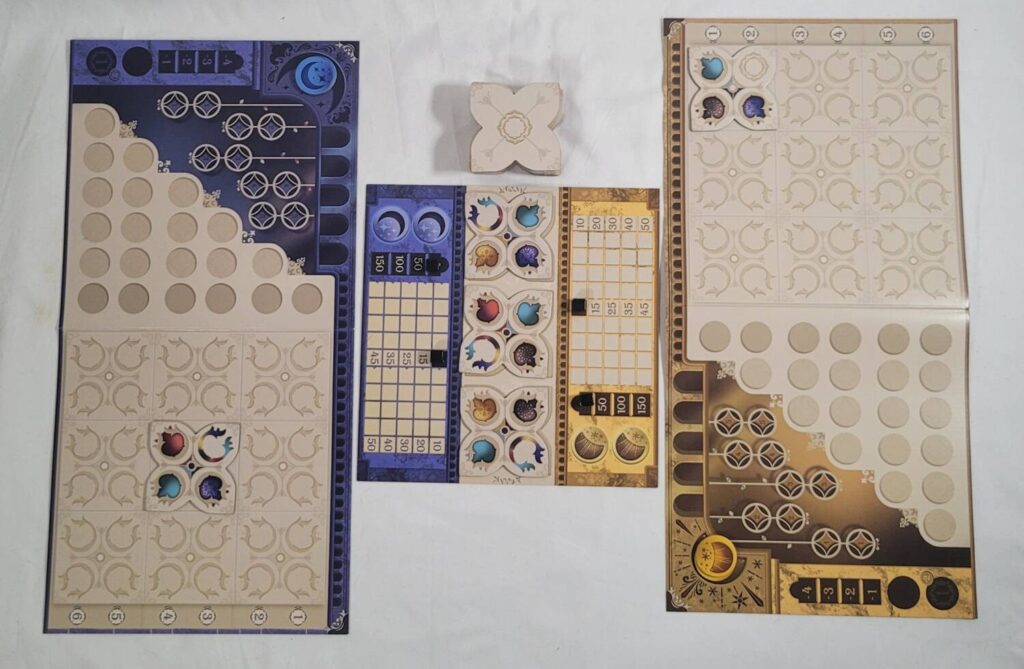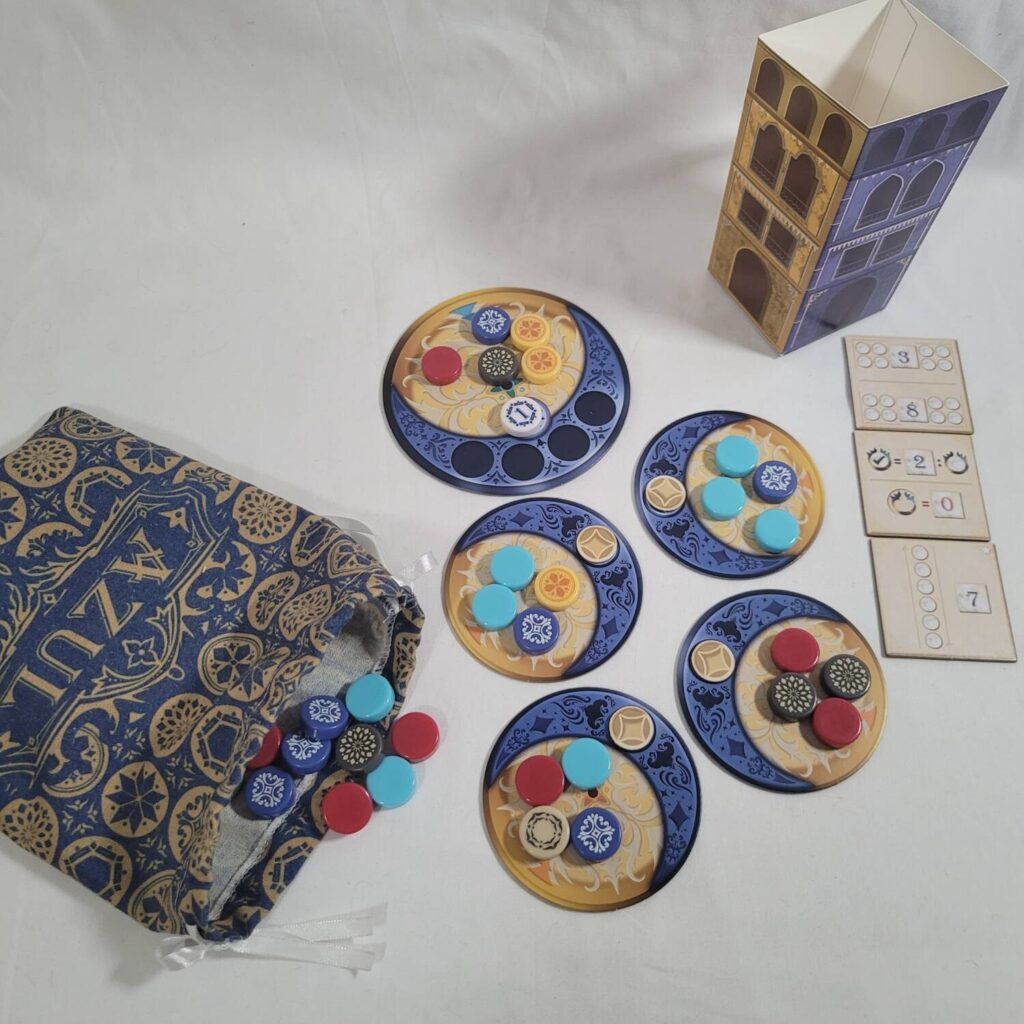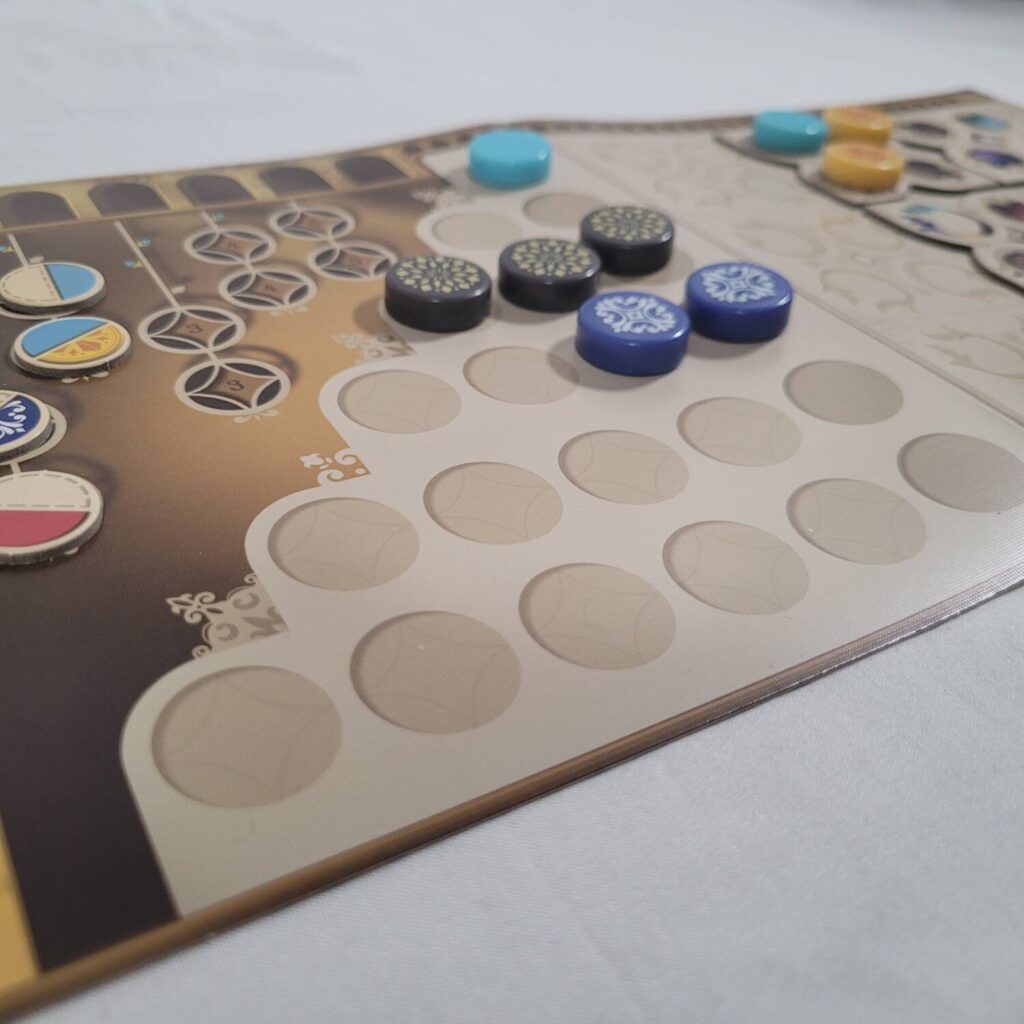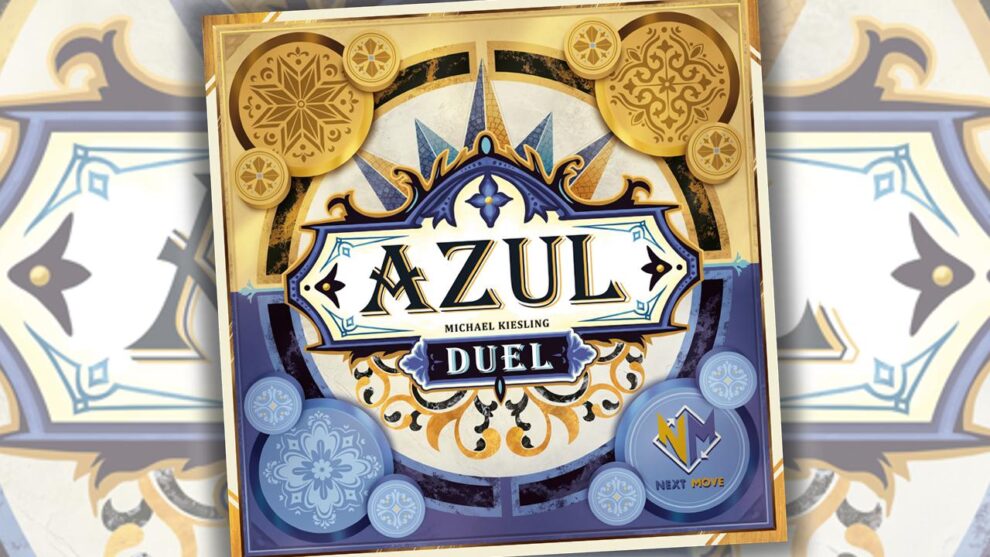Disclosure: Meeple Mountain received a free copy of this product in exchange for an honest, unbiased review. This review is not intended to be an endorsement.
When King Manuel I hired you to produce azulejo tile for his royal palace, he was not prepared for the astounding end results. When he tapped you to design the gardens that would surround it, he discovered that his expectations regarding the quality of your handiwork were well founded. When you were tasked with producing the stained glass panes for his new palace in Sintra, the end product only confirmed what he already knew: you are the best of the best. There is no other artisan in Portugal who can come close.
Well, with the exception of one other.
Impressed by the work you’ve done so far, King Manuel I has another request. Sintra’s ceilings are looking a little barren, and they could really benefit from your expert attention. This time, though, King Manuel wants to settle the debate about which artisan is the best. This time it’s just you and your toughest challenger yet.
Welcome to Azul Duel.
Azul Duel is an Azul experience tailored specifically for a head-to-head contest. In this review, my goal is to give you a good idea of how the game is played and to answer the burning question: was this game really necessary? If you’re already familiar with the gameplay of Azul Duel, feel free to skip ahead to the Thoughts section. Otherwise, read on as we learn how to play Azul Duel.
NOTE: For the rest of this review, I’m going to assume you have some experience with base Azul and will be mainly highlighting the differences. If you’re unfamiliar with Azul, I suggest you take a moment to familiarize yourself with it before continuing.
Setup
To set up for a game of Azul Duel, first gather up all of your tiles. Separate out the nine Special tiles and set them aside. Then, toss the remainder of the tiles into the bag. Lay out the factories (four small and one large), and populate the ‘sun’ portions of these with a number of tiles drawn randomly from the bag, four tiles per small factory and five for the large one. The large factory also receives the first player tile. Each ‘moon’ portion receives a random face-down Bonus chip.

Each player receives a Player board, its two matching Player tokens, and two Scoring markers. In between the players is placed the Scoring board, rotated in such a way that each player is sitting in front of their chosen color. Players then place their Scoring markers onto the 0 and 5 spaces of their section. Next, the Dome-plates are shuffled and placed into a face-down stack next to the Scoring board. Three of these are drawn and placed face-up into their locations. Then, three of the four Scoring tablets are selected and placed close by. Whichever side of these is face-up will determine the end-of-game scoring conditions.
Finally, determine the first player by some means and you’re ready to begin playing.
Acquisition
Each of the five rounds in Azul Duel is broken up into three distinct phases: acquisition, dome tiling and scoring, and preparation.
In the Acquisition phase, players will take turns drafting tiles from the factories and then adding them to the pattern lines on their boards, drafting Dome tiles and adding them to their board, or collecting Bonus chips.
For the most part, the tile draft functions exactly like Azul with a few notable differences. Firstly, when you draft a tile/tiles from the ‘sun’ side of a factory, the remaining tiles are no longer sent to the middle. Instead, they are stacked on top of the face-down Bonus tile in an order of your choosing. Also, when drafting from the large factory tile, you do not immediately gain the first player tile, as the first player tile is a part of that tile’s ‘moon’ side.
From this point on, instead of drafting from the ‘sun’ side of the factories, you may opt to draft from the ‘moon’ side instead. When drafting from a ‘moon’ stack, you acquire the top tile of that stack as well as the top tiles from all other stacks where the color of their top tile matches the color of the tile you drafted. Each tile in the ‘moon’ section of the large factory is considered to be a stack of one.
As an example, imagine there are three red tiles on the large factory and two small factory tiles with red tiles on top of their ‘moon’ stacks. If you decide to take the red tile from the top of a small factory tile’s ‘moon’ stack, you would gain five red tiles in total (along with the first player tile if you were the first person to take from the ‘moon’ side of the large factory tile).

If the ‘moon’ stack on a factory should ever become empty, then the Bonus chip on that factory gets flipped face up and becomes eligible to be drafted. Bonus chips feature one or two colors on them and can be used during the dome tiling and scoring phase to function as tiles—two of the same color equals one tile of that color or a combination of three, regardless of their colors, can be used to function as a single tile of any color.
The final object that can be drafted during this phase is a single Dome-plate. There are three of these, face up. When you take one of these, you’ll place one of your Player tokens onto the board to signify that you’ve used the action. You only have two Player tokens, so you can only use this action twice. Once taken, the Dome-plate is placed into an empty spot on your Player board in an orientation of your choice. Dome-plates do not refill once taken.
Astute observers may have noticed that there are only three face-up Dome-plates, but four Player tokens. So, what happens if the three face-up Dome-plates have been taken? Where does the fourth come from? Well, instead of drafting one of the face-up Dome plates, you may instead spend victory points to draw face-down Dome-plates from the pile (one point per Dome-plate). Then, you can look at them and select one to keep, returning the leftovers to the bottom of the stack.
Each Dome-plate’s face will contain three colored spaces that correspond to the tiles, as well as a fourth space that will either be a Joker space or a Special tile space. Joker spaces can accept tiles of any color during the dome tiling and scoring phase. Special tile spaces are filled in with one of the set aside Special tiles once the other three spaces of the Dome-plate are filled in. When this happens, you’ll score points equal to the total printed on the same row as the newly placed Special tile. The backs of each Dome-plate give you some indication of what’s on the other side: either a Joker or a Special tile space.
It is here in the Acquisition phase that Azul Duel truly pulls away from its predecessor. There’s a lot more going on and a lot more for the players to internalize. The next phase, for the most part, differs very little from its namesake.
Dome Tiling and Scoring
This phase is handled pretty much exactly the same as the end of round scoring in Azul, but there are a few minor differences. Just like Azul, if you have a completed pattern line, the rightmost tile in that row is moved onto a legal spot on a Dome-plate on the same row, and the remainders are dumped into the cardboard tower. However, if there is no legal spot, the tiles are stuck in that position until such a spot becomes available. And, if it ever becomes apparent that there will never be a legal spot, then the first four of those tiles are moved to the dropped tiles area. Once moved over, tiles score in exactly the same way as they do in Azul.
Unlike Azul, which has room on its floor line for seven tiles (worth a grand total of -14 points), Azul Duel’s Broken tiles space can only accommodate four (worth a total of -10). The first player marker occupies its own space and will incur a further -2 point penalty for whichever player claimed it.
Preparation and Endgame
The Preparation phase, as the name implies, is the phase in which the game is prepared for the next round. Players collect their Player tokens, new Dome-plates are drawn, and the factories are refilled. This phase is skipped at the end of the fifth round, and the game proceeds directly to endgame scoring.
In the endgame scoring, each of the Scoring tablets are considered to determine how many points the players score from each one. These totals are added to points scored during the game to determine the winner. Two of these scoring criteria are familiar from Azul—scoring points for completed horizontal and vertical rows—and that’s where the similarity ends. For instance: there is scoring for diagonals, scoring for filling in every rainbow spot on your Dome-plates, and points lost for not filling in Special tile spots (among several others).
Thoughts
Let’s face it: the duel-ization of popular board game titles is HOT right now. But, is it really necessary? Many of these games function just fine with two players. In fact, if you ask me, many of these games’ two-player modes are actually better than their ‘duel’ counterparts. For instance, many of us here at Meeple Mountain were left pretty disappointed with Splendor Duel. Even my beloved Uwe Rosenberg is guilty. When I play 2016’s Bohnanza: the Duel, I invariably find myself wishing I were playing Bohnanza instead. It’s hard to distill a 4- or 5-player experience down into a purely 2-player one while retaining the magic of the larger game, but also making the experience different enough that the existence of both games feels justified.
When you hear that a Duel version of one of your favorite games is being released, you’re right to be suspicious. You’re right to ask “Why?”. You aren’t alone in wondering “Is this just a cash grab?”. Such was my reaction when I heard there was a ‘duel’ version of Azul coming out.
Azul is a stellar game at any player count, and it works especially well at two. At two players, it’s super aggressive, extremely tight, and very challenging. At two players, it’s a game that makes you feel exceedingly clever and also incredibly stupid in equal measure. And, it’s a heck of a lot of fun. It’s pretty perfect in pairs, which begs the question: does it really need a two player version? Apparently, someone thought that it did.

When Meeple Mountain was initially offered a copy of the game for review, I passed on it; color me disinterested. Let Tyler take it on. But, when the publisher came back and told us they had a second copy, it felt like a sign. It felt like the universe was speaking to me, telling me that I’d made a mistake passing on it the first time around. Not being one to ignore the universe whispering in my ear, I grudgingly agreed to accept the second copy for review.
I’m glad I did because Azul Duel has completely replaced the Azul two player experience for me. In fact, it just might be my favorite version of Azul yet.
What makes Azul Duel so great is that it takes the thing that I love the most about Azul’s two-player mode—the clever, targeted sabotage of your opponent—and ramps it up significantly. In Azul, there were only two primary options for messing with your opponent: taking something they wanted or loading up the center to give them way more than they wanted, thereby forcing them to have to eat negative points. However, each of these was really only effective if they had no other choice. Azul rewards those who are able to successfully pivot when their plans become derailed.
Azul Duel still gives you those opportunities, but it does it in even sneakier, more clever ways than before. Consider a situation in Azul where there’s a factory containing a single red tile that you desperately need and three blue ones that you definitely don’t. In Azul, that pile of unselected tiles would go to the middle, free for the taking. Now, instead of those unselected tiles becoming a windfall for your opponent, they get stacked one on top of the other. That subtle distinction makes a world of difference, opening the game up to what my wife and I call ‘the camel dilemma’.
In the two player game of Jaipur, players are drafting cards from a shared line up of cards in an effort to create sets which are then turned in for points. Amidst the gems and precious metals that score points are camel cards which the game dictates cannot be taken from the lineup singly, but MUST be taken as a group. While the camels are incredibly useful, taking them frees up multiple spots for other cards which are immediately available to the next person in turn order. New cards equals better chances of putting together a set. Therefore, many games of Jaipur will at some point devolve into both players doing their best to force the other person to claim all the camels. A real head-to-head showdown.
In Azul Duel, a similar thing happens with the ‘moon’ stacks. Situations often arise wherein there is a potential large payout of same-colored tiles buried beneath a layer of other tiles. As a result, a standoff ensues. The players try to do everything they can to avoid being the one to remove the top layer of tiles, exposing the payout for the other player to grab up. Or, as is often the case, players will have to try to engineer it in such a way as to force their opponent to be the one to expose the payout. When your clever machinations bear fruit, it’s like a dopamine hit. It makes you want more.
Another thing that I really like about Azul Duel are the Scoring tablets and the way they force you to re-evaluate how you approach the game from one session to the next. What’s important this time may not be relevant the next time. They keep the game fresh and exciting in a way that Azul just can’t.
There’s a lot to like.
In fact, I like Azul Duel so much that unless I’ve got more than two-players, I can’t see a future in which I’ll ever pull Azul off my shelf ever again. It’s just that good.












Sigh. I guess I am buying another version of Azul…
Thanks for a great review!